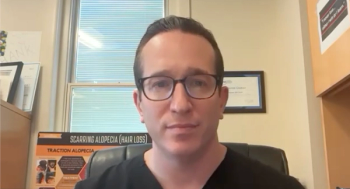
- ONCOLOGY Vol 11 No 9
- Volume 11
- Issue 9
5-FU or UFT Combined With Leucovorin for Previously Untreated Metastatic Colorectal Cancer
This phase III study compares leucovorin plus fluorouracil (5-FU) 425 mg/m2, days 1 through 5, 28-day cycle, with oral leucovorin plus oral UFT (tegafur and uracil) 300 mg/m2, days 1 through 28, 35-day cycle, in terms of
ABSTRACT: This phase III study compares leucovorin plus fluorouracil (5-FU) 425 mg/m2, days 1 through 5, 28-day cycle, with oral leucovorin plus oral UFT (tegafur and uracil) 300 mg/m2, days 1 through 28, 35-day cycle, in terms of efficacy, safety, quality of life, and pharmacoeconomics. Eligible patients have not been treated previously and have measurable or evaluable metastatic colorectal cancer, an Eastern Cooperative Oncology Group performance status of 2 or less, and adequate bone marrow, liver, and renal functions. Patients are evaluated for response clinically and by computed tomography. Responses are determined by World Health Organization criteria. The study is nearing completion, with no toxicity issues requiring protocol modification. The results of this study could lead to a change to oral therapy as the standard of care for metastatic colorectal cancer, providing the efficacy and toxicity of UFT/leucovorin are at least equivalent due to the ease of administration and patient preference for oral regimens.[ONCOLOGY 11(Suppl 10):48-49, 1997]
I
Phase II trials of the oral regimen, UFT (tegafur and uracil) plus leucovorin, have demonstrated that this combination has antitumor activity similar to intravenous regimens of fluorouracil (5-FU) plus leucovorin. [1,2] In addition, the toxicity of this oral regimen appears favorable in comparison to intravenous 5-FU regimens, with few patients demonstrating severe neutropenia or oral mucositis. UFT plus leucovorin is administered orally with continuous administration over 28 days, with interruptions if moderate or severe toxicity occurs. Prolonged oral administration may replicate a continuous infusion schedule of 5-FU, but with improved efficacy. In this study we have attempted to compare the efficacy, safety, and impact on quality of life of biomodulated 5-FU vs biomodulated UFT.
The primary goal of this study was to compare the survival rates of patients with previously untreated metastatic colorectal carcinoma in response to conventional 5-FU/leucovorin therapy vs UFT/leucovorin. Efficacy, safety, and quality of life assessments of the two treatment regimens also were compared. Additional study objectives included evaluation and comparison of the qualitative and quantitative toxicity and reversibility of toxicity of the oral (UFT/leucovorin) and intravenous (IV) (5-FU/leucovorin) regimens. Finally, the pharmacoeconomic data of the two treatment regimens were compared by calculating their incremental cost- effectiveness ratios. Differences between treatments in terms of consumption of resources and associated costs will be tested for statistical significance.
Eligible, consenting patients are randomized to either of the following treatments: (1) leucovorin 20 mg/m2/day by rapid IV injection days 1 to 5 preceding 5-FU 425 mg/m2/day by rapid IV days 1 to 5 on a 28-day cycle, or (2) leucovorin 25 mg tid orally days 1 to 28 with UFT 300 mg/m2/day (divided into three doses) orally on an empty stomach days 1 to 28 on a 35-day cycle.
Patients with previously untreated metastatic colorectal cancer with evaluable or measurable disease and good performance status (Eastern Cooperative Oncology Group £ 2) are eligible for entry into this study. Additional eligibility criteria include adequate bone marrow (absolute granulocyte count ³ 2,000/mm3, platelets ³ 100,000/mm3), liver (bilirubin normal), and renal (creatinine normal) function; and age of 18 years or older. Patients must be unsuitable for definitive surgical resection, and any prior adjuvant chemotherapy must have been completed more than 6 months prior to study enrollment. Patients also must be recovered from any surgery and have no unstable medical conditions, concurrent serious infections, or an oncologic emergency on presentation. Patients with a history of malignant neoplasms other than skin cancer or in situ carcinoma of the cervix are excluded.
Prior to study, all patients are evaluated by electrocardiogram, urinalysis, demographic questionnaire, and pregnancy test, if appropriate. Also at baseline, as well as prior to each cycle, patients undergo history evaluation and physical examination, including performance status, weight, vital signs, hematology, clinical chemistries, the Functional Living IndexCancer quality of life appraisal[3]; and toxicity assessment. Tumor measurement and a computed tomography scan of the abdomen and pelvis are performed at baseline, with repeat measurements every second cycle until response, then every third cycle.
Treatment continues until disease progression, or for 12 cycles in patients with stable disease. Patients may be withdrawn for severe or prolonged toxicity. Responses are determined by World Health Organization criteria.[4] Responding patients are treated until disease progression or, at the discretion of the investigator, for six cycles beyond a complete response.
Patients are monitored with weekly blood work and telephone contact. For patients treated with the 5-FU regimen, doses are reduced by 20% for grade 2 toxicity, and by 30% for grade 3 or 4 toxicity. In the absence of any toxicity greater than grade 1, 5-FU doses may be escalated first to 467 mg/m2/day and then to 514 mg/m2/day. For patients treated with UFT, treatment is interrupted for any grade 2 or greater toxicity, then resumed at 50% dose in those with grade 3 or 4.
The protocol was finalized May 31, 1994. Participating institutions were recruited from the United States, Canada, and Europe. The planned sample size was 632 to 800 subjects, depending on loss to follow-up.
A total of 816 patients have been enrolled in this trial, and no major modifications of the protocol have been required. An interim analysis has not been performed, but, for the 29 patients enrolled at our institution, we have a clinical impression of at least comparable tolerability and efficacy for the two regimens. We have been impressed that most patients treated with UFT have been able to be treated on schedule, with minimal need for interruption of treatment or dose reduction. Cycle 1 diarrhea and mucositis seem to be less common in the UFT/leucovorin group than in the 5-FU/leucovorin group.
There also has been a strong patient preference for oral dosing. No UFT-treated patient has requested change to standard therapy, and, although several patients have been troubled by chronic low-grade nausea or diarrhea, there have been no requests for discontinuation of therapy. Compliance seems to be excellent.
The results of this trial may alter the standard of care for patients with colorectal cancer. In the presence of similar efficacy between 5-FU and UFT, we would anticipate changing to oral therapy. The economic analysis will also be important. The tolerability of UFT as used in this trial suggests the potential for alternative schedules and combinations of therapy for this disease.
References:
1. Pazdur R, Lassere Y, Rhodes V, et al: Phase II trial of tegafur and uracil plus oral leucovorin. An effective oral regimen in the treatment of metastatic colorectal carcinoma. J Clin Oncol 12:2296-2300, 1994.
2. Gonzalez-Baron M, Feliu J, de la Gandara I, et al: Efficacy of oral tegafur modulation by uracil and leucovorin in advanced colorectal cancer. A phase II study. Eur J Cancer 31:2215-2219, 1995.
3. Schipper H, Clinch J, McMurray A, et al: Measuring the quality of life of cancer patients: The Functional Living Index-Cancer: Development and validation. J Clin Oncol 2:472-483, 1984.
4. Miller A, Hoogstraten B, Staquet M, et al: Reporting results of cancer treatment. Cancer 47:207-214, 1981.
Articles in this issue
about 28 years ago
UFT: East Meets West in Drug Developmentabout 28 years ago
Rationale for Phase I Study of UFT Plus Leucovorin and Oral JM-216about 28 years ago
Postoperative Adjuvant Chemotherapy for Non-Small-Cell Lung Cancerabout 28 years ago
UFT in Gastric Cancer: Current Status and Future Developmentsabout 28 years ago
Oral UFT and Leucovorin in Patients With Advanced Gastric Carcinomaabout 28 years ago
Experience With UFT in JapanNewsletter
Stay up to date on recent advances in the multidisciplinary approach to cancer.



















































































